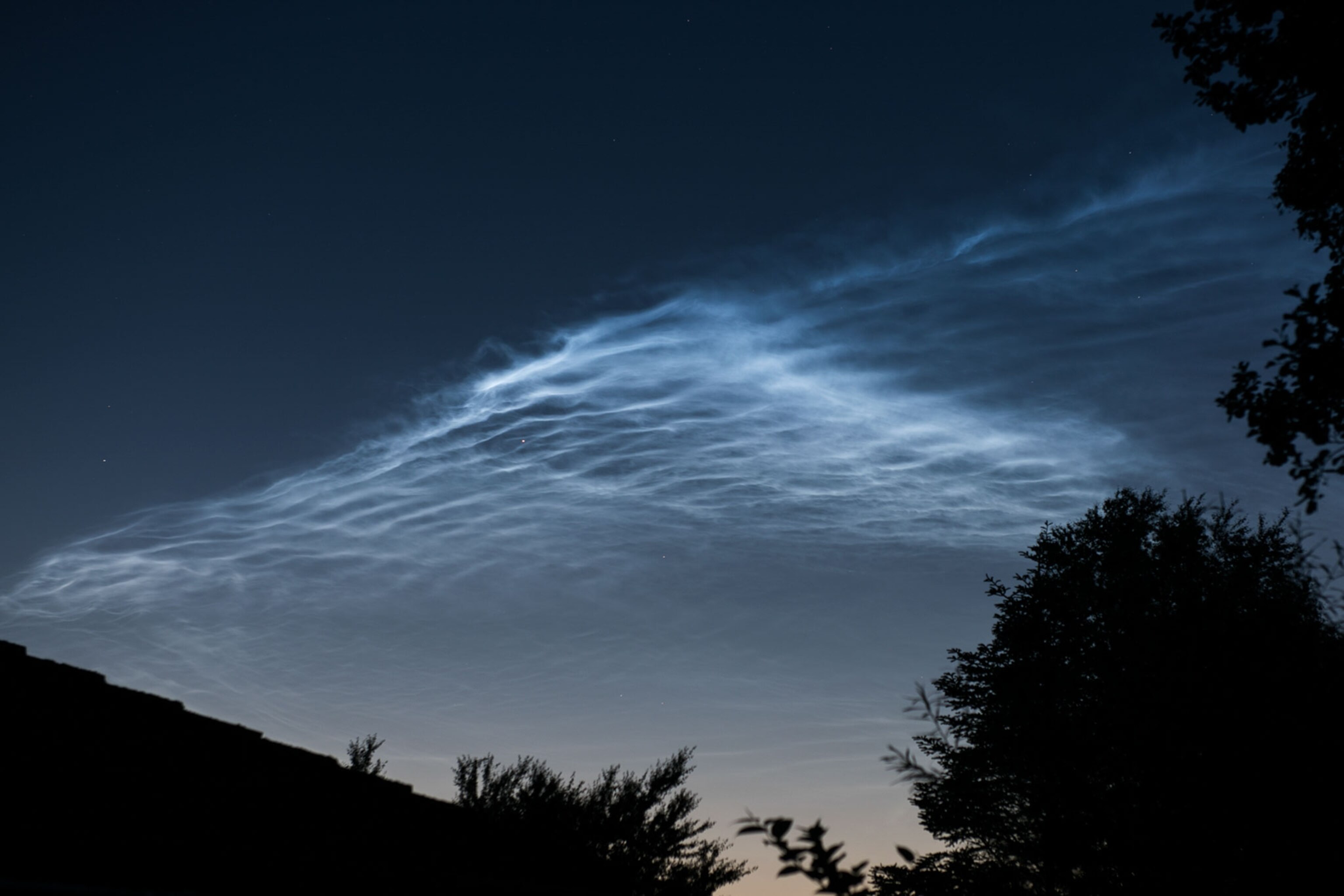




Now Is the Best Time to See Electric-Blue Clouds at Night
An outburst of noctilucent clouds signals the start of viewing season for these high-flying tendrils formed by space dust.
This week, reports started ramping up about eerie electric-blue clouds shimmering in nighttime skies in high-latitude regions. The stunning outburst of noctilucent, or night-shining, clouds hails the start of viewing season for these glowing, hypnotically dancing swirls.
The eye-catching wisps show up every year around local summer, and in the Northern Hemisphere sky-watchers can catch a glimpse of them painting the skies from now through August. Viewers in the Southern Hemisphere, meanwhile, should look for the clouds from November to February.
These mysterious, thin veils of clouds appear to form around Earth’s polar regions in the mesosphere, the highest level of Earth’s atmosphere. At these heights near the edge of space, around 50 miles (80 kilometers) up, temperatures are a bone-chilling minus 100 degrees Celsius (minus 148 degrees Fahrenheit), and the air is a million times drier than any desert.
Under these extreme conditions, water vapor freezes onto any dust particles floating in the region, seeding the ice crystals that form the tendrils and filaments of noctilucent clouds. Around dusk and dawn, the low-hanging sun brings the clouds to life, making them glow against twilight skies for surface observers.
Volcanoes and Space Dust
Noctilucent clouds were first recorded in 1885 after a volcanic eruption on the Indonesian island of Krakatau, which sent a massive ash cloud into the upper atmosphere that circled Earth for months. Spectacular red sunsets and the distinctive glowing clouds persisted for years.
While such large volcanic eruptions are not all that frequent, nearly a hundred tons of meteoritic dust fall on Earth every day, and this meteor smoke largely seeds the formation of noctilucent clouds.
People living in high latitude areas between 50º and 70º north have the best chance of seeing noctilucent clouds, although over the last century, the unusual sight has been spotted more frequently and much farther south in places such as Utah and Colorado, according to Spaceweather.com. While it's a mystery why the clouds appear to be spreading, some scientists have suggested a link to climate change.
The clouds are also visible from space—astronauts aboard the International Space Station have reported seeing them and have captured the occasional image. Similar clouds were even spotted on Mars back in 2006, when the Mars Express orbiter saw them floating some 60 miles (96.5 kilometers) high. On the red planet, the clouds are likely formed by frozen carbon dioxide.
To catch sight of this beautiful seasonal phenomenon, look toward the northwest when the sun is below your horizon about an hour after local sunset. You can also look for them in the mornings in the northeast about an hour before local sunrise.
Enjoy the show!
Andrew Fazekas, the Night Sky Guy, is the author of Star Trek: The Official Guide to Our Universe. Follow him on Twitter, Facebook, and his website.
Related Topics
You May Also Like
Go Further
Animals
- Orangutan seen using plants to heal wound for first timeOrangutan seen using plants to heal wound for first time
- What La Palma's 'lava tubes' tell us about life on other planetsWhat La Palma's 'lava tubes' tell us about life on other planets
- This fungus turns cicadas into zombies who procreate—then dieThis fungus turns cicadas into zombies who procreate—then die
- How can we protect grizzlies from their biggest threat—trains?How can we protect grizzlies from their biggest threat—trains?
- This ‘saber-toothed’ salmon wasn’t quite what we thoughtThis ‘saber-toothed’ salmon wasn’t quite what we thought
Environment
- What La Palma's 'lava tubes' tell us about life on other planetsWhat La Palma's 'lava tubes' tell us about life on other planets
- How fungi form ‘fairy rings’ and inspire superstitionsHow fungi form ‘fairy rings’ and inspire superstitions
- Your favorite foods may not taste the same in the future. Here's why.Your favorite foods may not taste the same in the future. Here's why.
- Are the Great Lakes the key to solving America’s emissions conundrum?Are the Great Lakes the key to solving America’s emissions conundrum?
- The world’s historic sites face climate change. Can Petra lead the way?The world’s historic sites face climate change. Can Petra lead the way?
History & Culture
- Meet the ruthless king who unified the Kingdom of Hawai'iMeet the ruthless king who unified the Kingdom of Hawai'i
- Hawaii's Lei Day is about so much more than flowersHawaii's Lei Day is about so much more than flowers
- When treasure hunters find artifacts, who gets to keep them?When treasure hunters find artifacts, who gets to keep them?
- Meet the original members of the tortured poets departmentMeet the original members of the tortured poets department
Science
- Why ovaries are so crucial to women’s health and longevityWhy ovaries are so crucial to women’s health and longevity
- Orangutan seen using plants to heal wound for first timeOrangutan seen using plants to heal wound for first time
- Should you be concerned about bird flu in your milk?Should you be concerned about bird flu in your milk?
Travel
- On this Croatian peninsula, traditions are securing locals' futuresOn this Croatian peninsula, traditions are securing locals' futures
- Are Italy's 'problem bears' a danger to travellers?Are Italy's 'problem bears' a danger to travellers?
- How to navigate Nantes’ arts and culture scene
- Paid Content
How to navigate Nantes’ arts and culture scene




